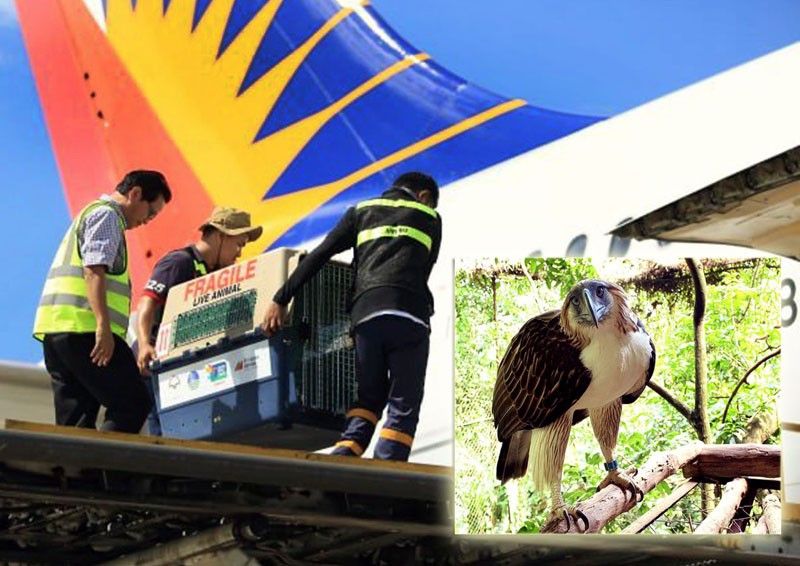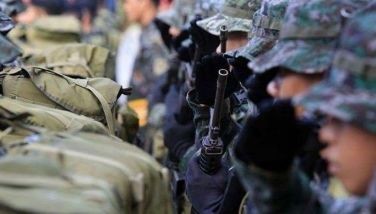2 Philippine Eagles flown to Singapore sanctuary

MANILA, Philippines — Two Philippine Eagles – the 15-year-old male named Geothermica and 17-year-old female partner Sambisig – were given special treatment at the Ninoy Aquino International Airport yesterday morning.
The couple – ambassadors of Philippine biodiversity – was loaned to Jurong Bird Park as part of the international Philippine Eagle Loan Agreement with Wildlife Reserves Singapore (WRS).
Bearing Philippine passports issued by the Department of Foreign Affairs (DFA) on June 4, 2019, they boarded Philippine Airlines (PAL) flight PR507 together with some Department of Environment and Natural Resources (DENR) officials, who made sure that all safety precautions were observed at the cargo compartment.
It is hoped that Geothermica and Sambisig, who both came from the Philippine Eagle Center (PEC) in Davao City, will breed during their two-year stay at the Jurong Bird Park, one of the zoological facilities managed by WRS. Their passports will expire on June 26, 2021.
PAL also flew Geothermica and Sambisig from Davao to Manila.
“Through the PAL Foundation, we are flying the loaned eagles to Singapore because we firmly believe in the eagle preservation advocacy of the PEF (Philippine Eagle Foundation),” said Jaime Bautista, PAL president and PEF vice chairman.
While PAL has a long experience in flying animals, this is the first time that a critically endangered species is receiving special treatment during flights.
PEF hopes that the WRS can help secure a gene pool of the Philippine Eagle for species conservation and as insurance against natural calamities that can wipe out the only captive eagle population at the PEC in Malagos, Davao City.
WRS, one of the world’s leading zoological institutions, has been supporting conservation efforts across Southeast Asia through wildlife research and awareness campaigns with over 50 wildlife conservation projects.
The preserved gene pool can also be critical in preservation efforts in case of health epidemics like avian flu.
According to the PEF, Geothermica and Sambisig are at the prime age for breeding. They were previously paired with other eagles at the Center but these attempts did not lead to natural pairing. Captive-bred eagles are said to be more resilient than those from the wild.
The PEF manages the PEC where both Geothermica and Sambisig were hatched and reared. Many of the eagles at PEC have corporate sponsors: Geothermica is sponsored by the Energy Development Corp. while Sambisig is sponsored by Dow Chemical Philippines.
PAL is also sponsor to an eagle named Sinag.
Meanwhile, officials in Bulacan province, which is also observing Philippine Eagle Week this June 4 to 10, are validating reports of sightings of Philippine Eagles flying over the Angat watershed.
Emelita Lingap, Bulacan provincial environment and natural resources officer, confirmed to the STAR that their office has already submitted a report to the DENR regional office for assistance and confirmation to make sure that the birds of prey seen in the area were really Philippine Eagles.
The sightings have been reported since last month, prompting the Bulacan environment office to put up streamers and posters with the message “Save the Philippine Eagle” in several strategic locations at the Angat watershed.
The DENR-Central Luzon said in a statement that its wildlife experts and biologists have been monitoring the vast and diverse mountain ranges of Sierra Madre, especially in portions of Nueva Ecija and Aurora provinces, to confirm the presence of the Philippine Eagle.
It added that local communities have observed in year 2000 large eagles flying in clear skies but could not be sure if these were really Philippine Eagles.
The sightings further gave hope to conservationists to continue their quest to confirm the existence of the Philippine Eagle in the Sierra Madre.
Agawid
In June 2016, an upland farmer found a juvenile female Philippine Eagle, approximately three years old, trapped in a snare or “silo” that was used in catching monkeys inside the Aurora Memorial National Park (AMNP).
This confirmed that the critically endangered species also exists in the Sierra Madre mountain range of Central Luzon.
The young eagle, which they named Agawid – an Ilocano word for “go home” – was turned over to the DENR-Community Environment and Natural Resources (CENRO) in Dingalan town.
In turn, it transferred Agawid to the Biodiversity Management Bureau (BMB), which took care of it for a time before releasing it back to the wild on Oct. 4, 2017.
Before the release, Agawid was transferred to a hack cage and brought back to a forest area in the national park of Aurora for a six-month hacking process, which they hope would ensure her survival and adaptive capacity in the wild.
Agawid weighed approximately 5.31 kilos just before release. She was fitted with a radio transmitter to help DENR authorities monitor her activities.
In April 2018, the DENR in Aurora and BMB conducted a re-trapping and monitoring for Agawid to check on her health condition. – With Ramon Efren Lazaro
- Latest
- Trending






























